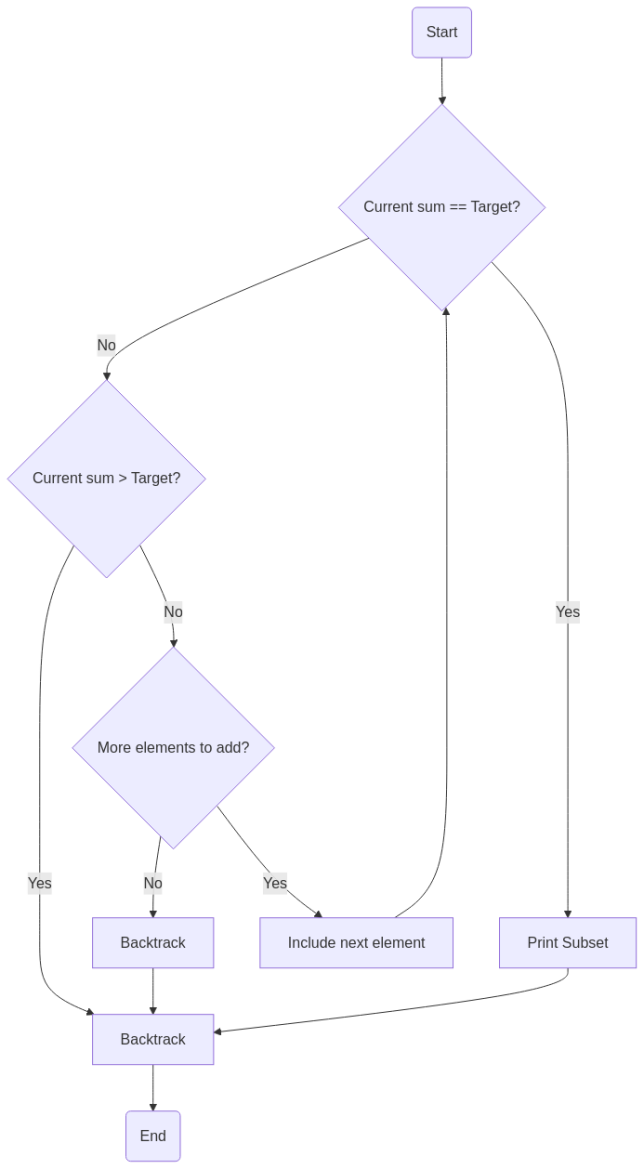The subset sum problem is a classic problem in computer science and is often solved using backtracking. The goal is to find subsets of elements selected from a given set whose sum adds up to a given number K.
Understanding the Problem
Given a set of n positive integers and a value m, the task is to determine all possible subsets whose sum is equal to m. This problem can be efficiently solved using backtracking.
Approach: Backtracking
Backtracking is a general algorithmic technique that incrementally builds candidates to a solution and abandons a candidate as soon as it is determined that the candidate cannot lead to a valid solution. In the subset sum problem, we:
- Start with an empty subset.
- Add elements one by one while keeping track of the sum.
- If the sum equals m, print the subset.
- If the sum exceeds m, backtrack and try another possibility.
Flowchart

Java Implementation
The following Java program implements the sum of subset problem using backtracking:
import java.io.*;
import java.util.*;
// Class to implement Sum of Subsets problem
class SubsetSum {
int targetSum; // Target sum to be found
int[] setElements; // Array to store set elements
int[] included; // Array to track included elements in subset
// Constructor to initialize arrays
public SubsetSum(int n) {
setElements = new int[n];
included = new int[n];
}
// Recursive function to find subsets whose sum equals targetSum
public void findSubsets(int currentSum, int index, int remainingSum) {
included[index] = 1; // Include the current element
// If a valid subset is found, print it
if (currentSum + setElements[index] == targetSum) {
printSubset(index);
} else if ((currentSum + setElements[index] + setElements[index + 1]) <= targetSum) {
// Recur to include the next element if it does not exceed target sum
findSubsets(currentSum + setElements[index], index + 1, remainingSum - setElements[index]);
}
// Backtrack: Exclude the current element and check next possibility
if ((currentSum + remainingSum - setElements[index] >= targetSum) && (currentSum + setElements[index + 1] <= targetSum)) {
included[index] = 0;
findSubsets(currentSum, index + 1, remainingSum - setElements[index]);
}
}
// Function to print the subset that meets the target sum
private void printSubset(int index) {
System.out.print("Subset found: ");
for (int i = 0; i <= index; i++) {
if (included[i] == 1) {
System.out.print(setElements[i] + " ");
}
}
System.out.println();
}
}
// Driver class to take input and execute the program
class SubsetSumDemo {
public static void main(String[] args) throws IOException {
BufferedReader reader = new BufferedReader(new InputStreamReader(System.in));
System.out.print("Enter the number of elements in the set: ");
int n = Integer.parseInt(reader.readLine());
SubsetSum subsetSumSolver = new SubsetSum(n);
int totalSum = 0;
System.out.println("Enter the elements of the set:");
for (int i = 0; i < n; i++) {
subsetSumSolver.setElements[i] = Integer.parseInt(reader.readLine());
totalSum += subsetSumSolver.setElements[i];
}
System.out.print("Enter the sum to be computed: ");
subsetSumSolver.targetSum = Integer.parseInt(reader.readLine());
System.out.println("Subsets whose sum is " + subsetSumSolver.targetSum + " are:");
subsetSumSolver.findSubsets(0, 0, totalSum);
}
}
Explanation of Code
- Class
SubsetSum:- Defines an array
setElements[]to store input set elements. - Uses
included[]to indicate whether an element is included in a subset. - Implements the backtracking function
findSubsets().
- Defines an array
- Backtracking Function
findSubsets(currentSum, index, remainingSum):- Adds elements to a subset and checks if their sum matches
targetSum. - If the sum is reached, the subset is printed.
- If adding the next element does not exceed
targetSum, it recurs further. - If no valid subset is found, it backtracks.
- Adds elements to a subset and checks if their sum matches
- Class
SubsetSumDemo:- Takes user input for the set and target sum.
- Calls
findSubsets()to compute and display subsets that sum totargetSum.
Sample Input/Output
Enter the number of elements in the set: 4
Enter the elements:
11 13 24 7
Enter the sum to be computed: 31
Subsets whose sum is 31 are:
Subset found: 24 7
Time Complexity Analysis
- The time complexity of this solution is O(2^n) in the worst case, as we are considering all subsets.
- Pruning through backtracking helps eliminate unnecessary recursive calls, making it more efficient than a brute-force approach.
The sum of subset problem is an excellent example of how backtracking can be used to efficiently solve combinatorial problems. The given Java implementation demonstrates an elegant way to find subsets whose sum equals a given target. This method is particularly useful in optimization problems and decision-making algorithms.
